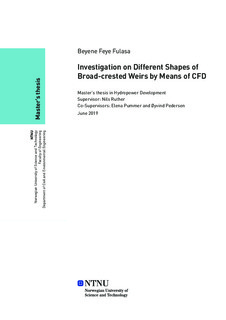| dc.description.abstract | Weirs are a type of hydraulic structure used for flow measurement, to regulate the water level in hydropower plants, and for the diversion of water to a reservoir. In this study, the flow over various shapes of broad-crested weirs was simulated by computational fluid dynamic models (CFD). The 14-extended water surface profiles over a sharp-edged broad-crested weir were measured in a laboratory by Hager and Schwalt (1994) and validated using OpenFOAM. A structured mesh with a high concentration near the wall regions was employed in the numerical model. Reynolds-averaged Navier-Stokes equations with five turbulence models: Standard k-Ɛ, RNG K-Ɛ, Realizable k-Ɛ, Standard k-ω, and KomegaSST were applied to estimate the water surface profiles. The best turbulence model, KomegaSST, was selected based on the least relative errors of the water level. The results of the numerical models were compared with experimental results to evaluate the accuracy of the available data and the ability of the model in describing the behavior of flow parameters over the weirs. There was good agreement between the approach water level and a small variation in the discharge coefficient within the range of 0.55 to 2.85% of the mean error.
In the first case, the weir geometry was modified on the edge of the weir both upstream and downstream with a straight and round cut. The impact of various shapes of weirs on the discharge coefficient and capacity was simulated and analyzed. In total, 40 numerical simulations were done on different weir geometries and the result indicated that the discharge coefficient increases as the weir geometry is modified from sharp-edged to either straight or round edged. By considering the minimum allowable crest length, the broad-crested weir with both sides modified has the maximum percentage of increment in the discharge coefficient (20.211%), compared with the experimental result of a square edge. For the selected model, the discharge coefficient equations were developed in terms of weir geometry relative length. A reasonable agreement was noticed between the developed discharge and Sargison and Percy’s (2009) equation., with a mean error of less than -1.68%.
The second case of numerical simulation of flow over a broad-crested weir was investigated by modifying the slope of the crest from the upstream to the downstream edge of the weir with an inclination angle of 0° to 5°. In this case, 36 simulations over different shapes of weirs were carried out and the effect of both straight-cut and round-edged on the formation of the re-circulation zone was investigated. From all modifications, the weir with a rounded edge and crest inclination of 5° was selected as the best model. With this model, the capacity of the weir was increased by 14.91% compared with the square-edged weir, and the equations for the discharge coefficient were developed both in terms of angle of crest inclination angle (α) and relative length. | |
